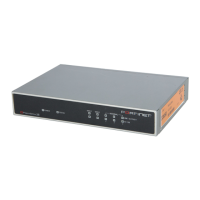44 01-28006-0010-20041105 Fortinet Inc.
Changing the FortiGate firmware System status
For this procedure you:
• access the CLI by connecting to the FortiGate console port using a null-modem
cable,
• install a TFTP server that you can connect to from port1. The TFTP server should
be on the same subnet as port1.
Before beginning this procedure you can:
• Back up the FortiGate unit configuration.
For information, see “Backing up and Restoring” on page 124.
• Back up the IPS custom signatures.
For information, see “Backing up and restoring custom signature files” on
page 305.
• Back up web content and email filtering lists.
For information, see “Web filter” on page 329 and “Spam filter” on page 343.
If you are reverting to a previous FortiOS version (for example, reverting from FortiOS
v2.80 to FortiOS v2.50), you might not be able to restore your previous configuration
from the backup configuration file.
To install firmware from a system reboot
1 Connect to the CLI using the null-modem cable and FortiGate console port.
2 Make sure that the TFTP server is running.
3 Copy the new firmware image file to the root directory of the TFTP server.
4 Make sure that port1 is connected to the same network as the TFTP server.
5 To confirm that the FortiGate unit can connect to the TFTP server, use the following
command to ping the computer running the TFTP server. For example, if the IP
address of the TFTP server is 192.168.1.168, enter:
execute ping 192.168.1.168
6 Enter the following command to restart the FortiGate unit:
execute reboot
The FortiGate unit responds with the following message:
This operation will reboot the system !
Do you want to continue? (y/n)
Note: Installing firmware replaces the current antivirus and attack definitions with the definitions
included with the firmware release that you are installing. After you install new firmware, use the
procedure “To update antivirus and attack definitions” on page 129 to make sure that antivirus
and attack definitions are up to date.

